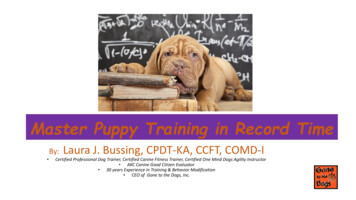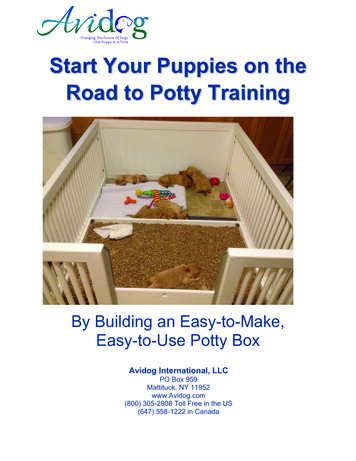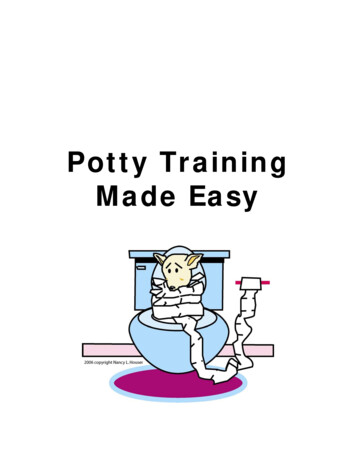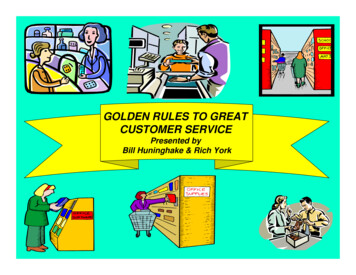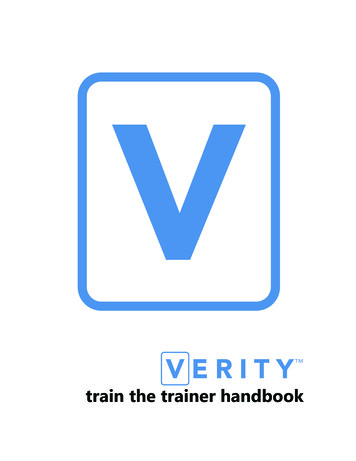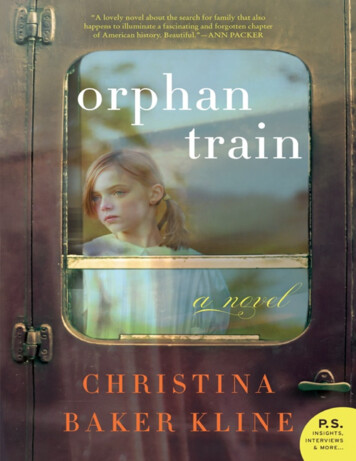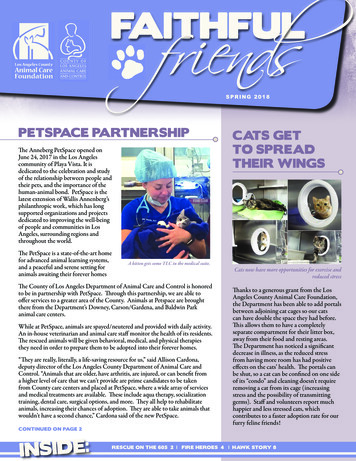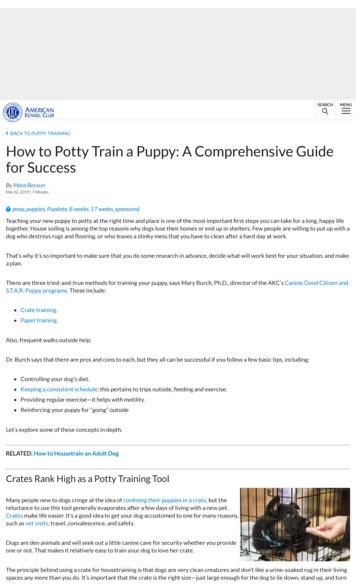
Transcription
SEARCHMENUBACK TO PUPPY TRAININGHow to Potty Train a Puppy: A Comprehensive Guidefor SuccessBy Mara BovsunMar 02, 2019 7 Minutespoop, puppies, Pupdate, 8 weeks, 17 weeks, sponsoredTeaching your new puppy to potty at the right time and place is one of the most important first steps you can take for a long, happy lifetogether. House soiling is among the top reasons why dogs lose their homes or end up in shelters. Few people are willing to put up with adog who destroys rugs and flooring, or who leaves a stinky mess that you have to clean after a hard day at work.That’s why it’s so important to make sure that you do some research in advance, decide what will work best for your situation, and makea plan.There are three tried-and-true methods for training your puppy, says Mary Burch, Ph.D., director of the AKC’s Canine Good Citizen andS.T.A.R. Puppy programs. These include:Crate training.Paper training.Also, frequent walks outside help.Dr. Burch says that there are pros and cons to each, but they all can be successful if you follow a few basic tips, including:Controlling your dog’s diet.Keeping a consistent schedule; this pertains to trips outside, feeding and exercise.Providing regular exercise—it helps with motility.Reinforcing your puppy for “going” outsideLet’s explore some of these concepts in depth.RELATED: How to Housetrain an Adult DogCrates Rank High as a Potty Training ToolMany people new to dogs cringe at the idea of confining their puppies in a crate, but thereluctance to use this tool generally evaporates after a few days of living with a new pet.Crates make life easier. It’s a good idea to get your dog accustomed to one for many reasons,such as vet visits, travel, convalescence, and safety.Dogs are den animals and will seek out a little canine cave for security whether you provideone or not. That makes it relatively easy to train your dog to love her crate.The principle behind using a crate for housetraining is that dogs are very clean creatures and don’t like a urine-soaked rug in their livingspaces any more than you do. It’s important that the crate is the right size—just large enough for the dog to lie down, stand up, and turn
around. If it is too large, the dog will feel that it’s OK to use one corner for elimination and then happily settle down away from the mess.Many crates come with partitions so you can adjust the size as your puppy grows.When she feels an urge, the puppy will usually let you know by whining and scratching. That’s her signal that she has to go and wants outof her little den. Now! Don’t delay because if you let your pup lose control in her crate, she’ll get the idea that it’s OK to mess up herliving space. Then she’ll think nothing of leaving little packages around where you live, too.Puppy Pads and Paper TrainingDr. Burch says the use of puppy pads and paper training can be “tricky because you’re reinforcing two different options for the puppy.”In an ideal situation, pups would learn to hold it indoors and only eliminate at specific spots outdoors. But some cases may require a bitof creative thought, such as a person who has a job that makes it impossible to get home several times a day, or for a tiny dog livingwhere the winters are brutal. Puppy pads give a dog the option of relieving herself in an approved spot at home. After the dog matures,the owner can then work on having the dog do her business outdoors all the time.Create a Housetraining Schedule for Your PuppyIt is vital to housetraining success. Puppies have tiny bladders, and water runs right through them. The same is true for solid matter. Youhave to make sure you are giving your puppy ample opportunity to do the right thing.A good guide is that dogs can control their bladders for the number of hours corresponding to their age in months up to about ninemonths to a year. (Remember, though, that 10 to 12 hours is a long time for anyone to hold it!) A 6-month-old pup can reasonably beexpected to hold it for about 6 hours. Never forget that all puppies are individuals and the timing will differ for each.Monitor daily events and your puppy’s habits when setting up a schedule. Withvery young puppies, you should expect to take the puppy out:First thing in the morning.Last thing at night.After playing indoors.After spending time in a crate.Upon waking up from a nap.After chewing a toy or bone.After eating.After drinking.This could have you running for the piddle pad, backyard, or street a dozen times or more in a 24-hour period. If you work, make somekind of arrangement (bringing your pup to the office or hiring a dog walker) to keep that schedule. The quicker you convey the idea thatthere is an approved place to potty and that some places are off-limits, the quicker you’ll be able to put this messy chapter behind you.Observation and SupervisionYou have to watch your puppy carefully for individual signals and rhythms. Some puppies may be able to hold it longer than others.Some will have to go out every time they play or get excited. Some will stop in the middle of a play session, pee, and play on. As withhuman babies, canine potty habits are highly idiosyncratic.Control the DietPuppies have immature digestive systems, so they can’t really handle a lot of food. That’s why itis recommended that you break up the feedings into three small meals. Another thing to keepin mind is the food itself, which should be the highest quality. Whatever you choose, make sureit agrees with your puppy.You might want to check out one of the four distinct Purina Pro Plan nutritional platforms.They have different formulas for your pup’s particular needs and preferences. Real meat is thefirst ingredient AND there are no added artificial colors or flavors.Examining their stool is the best way for an owner to figure out whether it’s time for a change in diet. If your puppy is consistentlyproducing stools that are bulky, loose, and stinky, it may be time to talk to your vet about switching to a new food. Overfeeding may alsoprovoke a case of diarrhea, which will only make the task of housetraining that much more difficult.PraiseScolding a puppy for soiling your rug, especially after the fact, isn’t going to do anything except make her think you’re a nut. Likewise,some old methods of punishment, like rubbing a dog’s nose in her poop, are so bizarre that it’s hard to imagine how they came to be andif they ever worked for anyone. On the other hand, praising a puppy for doing the right thing works best for everything you will do inyour life together. Make her think that she is a little canine Einstein every time she performs this simple, natural act. Be effusive in your
praise—cheer, clap, throw cookies. Let her know that no other accomplishment, ever—not going to the moon, not splitting the atom, notinventing coffee—has been as important as this pee. Reward your pup with one of his favorite Purina Pro Plan treats. Make surethey’re nice and small, easy for your puppy to digest.If your dog has an accident, says Dr. Burch, don’t make a fuss, just clean up the mess. A cleaner that also kills odors will remove the scentso the dog will not use it in the future. Blot up liquid on the carpet before cleaning the rug.If you catch the dog starting to squat to urinate or defecate, pick her up and immediately rush outside. If she does the job outdoors, giveher praise and attention. Remember that when it comes to housetraining, prevention is the key.Housetraining ProblemsFollowing these rules will usually result in a well house-trained puppy. But sometimes, it doesn’t go as planned.Dr. Burch notes that sometimes house soiling is a sign of a physical issue. “Well before the several month mark, a dog who has seemedimpossible to housetrain should have a good veterinary workup,” she says. If your vet finds that your dog is healthy, the next step is tofind a trainer or behaviorist who has had experience with this issue.Here are some common complaints that trainers say they have encountered:“My lapdog is piddling all over the house!” This is common among people who own toy dogs. Some trainers recommendteaching little dogs to use indoor potty spots, in much the same way as a cat uses a litter box. In addition to piddle pads, there areactual potty boxes for indoor use. Other trainers say that with consistency, you can house train a little dog. It just may take a littleadditional time, attention, and effort.“My dog keeps peeing in the same spot where she had an accident.” That’s probably because you didn’t clean up the messefficiently and there is still some odor there, signaling that this is a prime potty spot. In your new puppy supply kit make sure youhave plenty of enzymatic cleaners and carefully follow instructions on using them.“I gave her the run of the apartment. When I came home, there was a mess.” This is a common mistake among dog owners.They see some early signs that the dog is getting the idea, and declare victory too soon. Even when the puppy is consistently doingwhat you want, keep to the schedule to make sure the good habits are ingrained.“He’s soiling his crate!” Dr. Burch says dogs who come from pet stores, shelters, or other situations where they have beenconfined for long periods and have had no other choice but to eliminate in their kennels will often soil their crates. The bestapproach would be to go back to square one with crate and house training. Here are the steps to follow:Assess how well your dog can control his bladder and bowels when not in the crate.Carefully controlling diet and schedule.Give frequent trips outside, including after every meal, first thing in the morning and last thing at night.If you work, consider a dog walker.Clean everything so there are no odors left.How Long Does Puppy Potty Training Take?That can vary considerably, says Dr. Burch. There are many factors to consider, such as age, learning history, and your methods andconsistency. An 8-week-old puppy is very different developmentally than a 5-month-old puppy. Some puppies have perfect mannersafter just a few days. Others can take months, especially if the dog has had a less than ideal situation before coming to you. Withpatience and persistence, though, most dogs can learn.For additional tips, here’s an AKC webinar on housetraining a puppy.
Sponsored by Purina Pro Plan .Sponsored by Purina Pro Plan Get Your Free AKC eBookTips forResponsible DogOwnersThis e-book is a great resource foranyone who's considering dogownership or already owns a dog.Download for tips on how to be thebest dog owner you can be.First NameLast NameEmail
SUBMITAKC Privacy PolicyYou May Also LikeLIFESTYLEThe Top 100 Boy Dog NamesHEALTHFirst-Year Puppy Vaccinations: A Complete Guide
NUTRITIONHuman Foods Dogs Can and Can’t EatFetch great deals in the AKC StoreSHOP NOW
Shop Products:Rice Hull Dog Bowls & TrayCustom Slate Sign 54.99 49.99Brainiac Pack - Assortmentof Interactive Dog Toys 35.99Border Collie Collar andLeash Set 31.99Get The AKC Nibble newsletter!Essential info about dog health, training, sports and more.EMAILyou@yourdomain.comSIGN UPFor all AKC Newsletters, click hereAKC Privacy PolicyFounded in 1884, the AKC is the recognized and trusted expert in breed, health and training information for dogs. AKC activelyadvocates for responsible dog ownership and is dedicated to advancing dog sports.
ABOUT AKC TOP SERVICES TOP RESOURCES GET INVOLVED FAVORITE THINGS AdvertisingTerms of UsePrivacy & CookiesCA Privacy RightsWebsite Info & FAQsLinking PolicyMaterial Reproduction Policy
BACK TO PUPPY TRAINING poop,puppies,Pupdate,8 weeks,17 weeks,sponsored Teaching your new puppy to potty at the right time and place is one of the most important first steps you can take for a long, happy life together. House soiling is among the top reasons why dogs lose their homes or en
